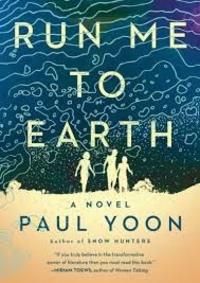Run Me to Earth by Paul Yoon
 Wednesday, January 29, 2020 at 6:48AM
Wednesday, January 29, 2020 at 6:48AM 
Published by Simon & Schuster on January 28, 2020
Many fine novels have been set during the Vietnam War, telling a brutal story from the perspective of American soldiers. Less common are stories told from Asian perspectives. The war took far more lives of Vietnamese than Americans. It spilled into neighboring countries, disrupted families, and destabilized societies. The central characters in Run Me to Earth are Laotians whose lives were changed — or ended — by the war.
Laos was littered with American cluster bombs during the war in an effort to close supply lines used by the North Vietnamese. Unexploded bombs the size of baseballs continue to kill Laotians fifty years later. The war sparked a conflict in Laos between the Pathet Lao and the Royal Lao Government. The CIA supported the RLG in a futile effort to thwart the spread of communism. Part of that support consisted of training Hmong fighters to resist the Pathet Lao.
The initial focus of Run Me to Earth is on a Laotian hospital that helps wounded Hmong fighters and civilians. In exchange for American dollars, Prany and Alisak work in the hospital. They were recruited to the job at the age of sixteen. Prany’s sister Noi is a year younger than Prany.
The three live together in a nearby farmhouse that was once owned by a Frenchman who is known to locals as the Tobacco Captain. When Noi was twelve, the Tobacco Captain hired her to help in the kitchen at a party. Noi will not talk about that day, but a later chapter gives us a glimpse of Noi’s experience.
In 1969, when Prany and Alisak are seventeen, American planes arrive to evacuate the hospital workers. A doctor named Vang expects Prany, Alisak, and Noi to join him on the plane. Much of the novel recounts their harrowing journey toward evacuation, a journey that only one of those four characters will complete. That character makes it to France, where he stays in the home of the Tobacco Captain’s brother.
Five years later, the story follows a woman named Auntie who, for a price, smuggles Laotians into refugee camps in Thailand. She yearns for the optimistic time, before the appearance of American aid, when villagers did not realize they lived in poverty. She hears about two familiar characters who have been captured by the Pathet Lao and brutally interrogated. Three years later, the story follows those two characters after their release. They are assigned to work on a village farm, but they have other ideas about where and how they want to live. The meaning of freedom in the midst of war and poverty is one of the novel’s important themes.
Toward the end of the novel we learn about a sacrifice that a character makes so that a girl named Khit can leave Laos. She eventually makes her way to America with a couple who pretend to be her parents. Her new family assimilates as immigrants will do when given the chance, eventually opening a restaurant in Poughkeepsie, yet Khit lives in constant fear that her new life will be taken from her. Fifteen years later she travels to France so that she can keep a promise she made on the day she was smuggled out of Laos. There she learns partial answers to questions the reader will have about the fate of other characters.
Tension becomes palpable as the primary characters struggle to escape the lives that shackle them. They often do so in unexpected ways. Although a work of fiction, Run Me to Earth is infused with details that remind the reader of the tragedy that resulted from America’s intervention in Vietnam and neighboring countries. At the same time, the story invites the reader to make connections to other tragedies — of war, of oppression, of prejudice — all stemming from weaknesses in the human spirit that are partially offset by those who find the strength to resist.
The novel tells a powerful and moving story about characters who make difficult choices under unimaginable circumstances. One choice involves violent retribution, an understandable act even if it is morally questionable. On other occasions, the characters make selfless choices that place the welfare of their friends above their own. Notwithstanding the larger issues that permeate the story, Paul Yoon’s focus on ordinary people in an extraordinary situation gives the novel its heart. Friends are lost and new friends are made. Lives change but survivors endure because others sacrifice. It is impossible not to be wrenched by their pain and inspired by their fundamental decency.
HIGHLY RECOMMENDED
 TChris |
TChris |  Post a Comment |
Post a Comment |  HR,
HR,  Paul Yoon in
Paul Yoon in  General Fiction
General Fiction
Reader Comments